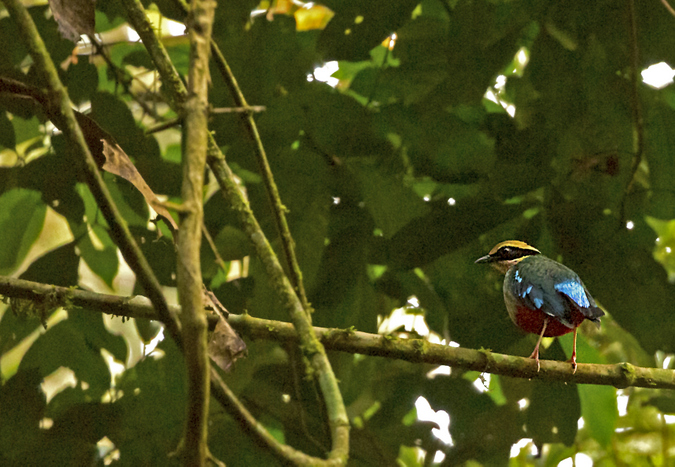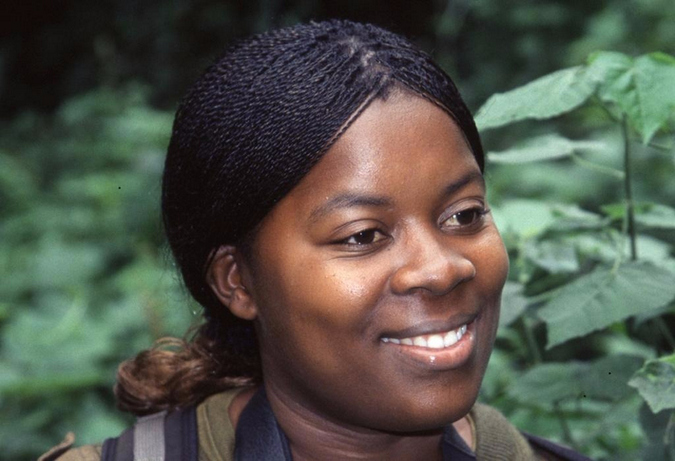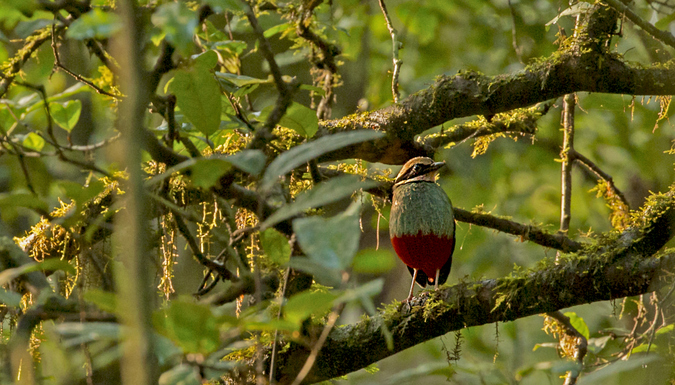
Written, and photographs, by Christian Boix
I am standing still, deep inside Uganda’s Kibale National Park. It is dark, way too early in the morning, and a lush canopy above my head mantles today’s dawn. There is an eerie and almost deafening silence, unlike the conspicuously noisy forests I have visited in West Africa, South America and southeast Asia.
My aim today is to listen out for the green-breasted pitta, to track it down to its perch and stealthily approach it to take a decent photo. I tell myself to stay focused – perhaps my luck will change today. I close my eyes and scan the silence with my ears. I am listening for a quasi-imperceptible frog-like “proop”, from somewhere in the forest canopy. The call itself is a rather subdued tremolo – more like a frog than a bird.
So how then was this bird ever found in this forest you may ask? And why have only a handful of birders ever laid eyes on a green-breasted pitta before? The answer is truly charming…
The re-discovery of the green-breasted pitta in Kibale National Park, as told by Ranger Harriet Kemigisha
“I was a ranger guide in Kibale National Park, mostly taking out clients for birding and chimpanzee tracking in this beautiful rainforest. On June 21st 2005, I had a group of six clients which I took out for chimpanzee tracking.
We came across a fruiting fig tree (in an area well-known to us guides) where we found chimps feeding high up on the fruits. We watched them for about 30 minutes until they all descended and started walking on the ground at a very fast pace, so we decided to follow them. Somehow I lost sight of them, but I could hear them calling from a distance of about 300 metres. Blindly following the chimps we had wandered off the trail and were now thoroughly lost!
The good thing was that I had a radio and was able to get in touch with my other colleagues in the forest. I called Godfrey and talked to him in our local language Rutoro, to make sure that the clients don’t know that we were lost in the forest.
‘Nyowe Mbuzile nabagenyi timanyile ambilendi’, I said to him, which basically means: “I am lost with visitors and I have no idea where I am”.
He told me to walk towards the sounds of the chimps, which I did, all the while making sure that my clients thought their guide was looking for more chimps and not totally lost.
As I walked in the direction my colleague gave me, I spotted a beautiful bird hopping on the ground like a thrush. I turned to my clients in excitement and said, ‘That’s a pitta!’. My clients were not interested in birds at all and they ignored my pitta.
I kept watching the bird as it carried nesting materials, but my clients were impatient as they were only interested in seeing the chimps. We continued following the calls of chimps until we ended up at the same fig tree where we were at before, to find more chimps feeding. We were not lost anymore!
This helped me to estimate the distance from where I had seen the pitta. We walked back to Kanyachu visitor centre and I shared my good news of the pitta and quickly picked up the bird book to properly identify it – but the book only had one species of pitta – the African pitta, which didn’t look like the one I had just seen in the forest.
I called Hassan Mutebi, who had left Kibale a few days ago with a Spanish birder Ignacio Ufera. I told him that I had seen a pitta but did not look like an African pitta. Hassan shared the news with his client and they immediately changed their itinerary and came back to Kibale the next day.
I guided them to the exact spot where the bird was and we all started looking on the ground when I heard Ignacio shouting, ‘I have seen it, there are two!’.
Since then, the news of the green-breasted pitta in Kibale has spread all over the world. Pitta experts say that this is the most difficult and unknown species of pitta in the world.
After this discovery, there was an increase of birding groups to Uganda by 80%, and I was getting many bookings for guiding from various birding groups – and with each group I successfully located the pitta.
I have now learnt the pitta’s various behaviours, from feeding and breeding, to displaying and territories. I feel like I know this bird like I know myself.”

And that is how the green-breasted pitta became a traceable species in Kibale, part luck, part know-how and a healthy wallop of grit, determination and birding passion.
So here I am in Kibale, with Harriet as my guide. It’s my sixth time trying to catch a glimpse of this iconic species. I have prayed to each and every birding god I know for assistance, as I am not sure I can handle being stood up yet again. As it is, this pitta already holds the dubiously honourable rank of number ONE African bogey bird in my books, a title am hoping to lose today.
Timing is key, for hearing its call is essential to narrowing down the search area. They are most likely to call in (February and June) and one is more likely to hear it when the forest is quiet, in the morning, just before the usual dawn chorus – at other times forest soundscape drowns out the soft call. Alternatively, they are known to breed in June-July and the bird guides in Kibale have realised how sought-after this bird is, and have developed a stellar approach to showing nesting couples to clients, from a safe distance, without affecting breeding. Outside of these months, one has almost no chances of catching a glimpse of this bird on the forest floor.
Suddenly, there is a subdued and distant “proop”, and we all lock onto the sound. Torches off, and with brisk but mindful steps we close the gap. Harriet orchestrates the best approach, knowing already which individual it is and his perching preferences. It takes another 5 or 6 “proops” for the bird to drop off from the canopy, and soon enough the “prooping” emanates from a mere five metres off the ground and right in front of us.
“Scan that tree,” Harriet orders.
And my word… after two sweeps my eyes land on a mossy, sunlit branch where the distinct shape and colours of my quarry appear as if by magic! Seconds later I see the coveted ‘twitch’ display, as it hops into the air whilst “prooping” and claiming stake to this patch of forest.

I am elated, excited, riveted as I absorbing every second and my brain buffers as it downloads the sights and sounds of this stunning bird and its stellar display. For the next 20 minutes a number of sun-flecked branches are used to call and display, until the bird eventually drops to the forest floor. And disappears.
We relocate it, and follow it for an hour. It is easy to lose sight of this dumpy, thrush-like bird – as colourful as it is. Green-breasted pittas will dash from one dappled shadow to the next, slaloming past sun flecks on the forest floor, revealing itself on its own terms. Like a puff of smoke, this Houdini will evaporate from plain sight as it blends into the background, and appear yonder as if to tease you. It is clear to me that one cannot observe a green-breasted pitta if it does not want to be seen. Needless to say, one needs to be focused and save the blinking for later.
Stealth is paramount. Maintaining the right distance, pre-empting its next dash, and understanding the terrain are important factors to consider in order to get a decent, prolonged view. One wrong move, and it will disappear, or worse, it will flush and fly into a densely wooded area, or straight up to the canopy. Gone.
Thank you Harriet, for sharing your forest, knowledge and awesome green-breasted pitta.
Watch the green-breasted pitta in action, filmed by Christian Boix in Kibale National Park – don’t forget to turn up the sound to hear the “proop” and the chimps!
Should you be interested in trying your luck on a ‘Pitta Quest’, have a look at our 4-night itinerary here, and do not hesitate to contact us should you require further information. Whether it is African (Angolan) or the green-breasted pitta, we will do our best to deliver.
The best time of the year to see green-breasted pittas is mid-June, July, August, and February/March, plus early April.
There are two pitta species in Africa, and approximately 42 elsewhere in the world, mostly in southeast Asia. They are all drop-dead gorgeous, but the African representatives are much harder to find (in my opinion).
To comment on this story: Login (or sign up) to our app here - it's a troll-free safe place 🙂.![]()






